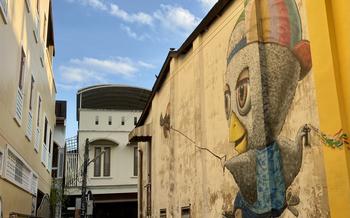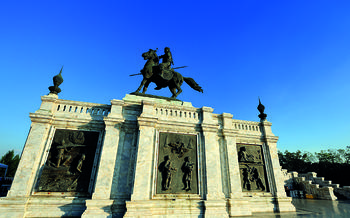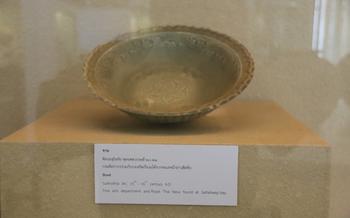
Gibbon Rehabilitation Project
- Gibbon Rehabilitation Project
- Location and Access
- Working Hours
- Guided Tours
- Gibbon Encounters
- Forest Walk
- Gibbon Feeding
- Interactive Exhibits
- Conservation Efforts
- Research and Data Collection
- Volunteer Opportunities
- Gift Shop and Souvenirs
- Accommodation and Dining
- Nearby Attractions
- Insider Tip
Gibbon Rehabilitation Project
The Gibbon Rehabilitation Project in Phuket City, Thailand, is a remarkable initiative dedicated to the conservation and rehabilitation of gibbons, fascinating and endangered primates native to Southeast Asia. Established in 1992, the project's mission is to rescue, rehabilitate, and release gibbons back into their natural habitats, while simultaneously promoting education, research, and community engagement to ensure the long-term survival of these incredible creatures.
The importance of gibbon conservation cannot be overstated. Gibbons play a crucial role in maintaining the ecological balance of Southeast Asian rainforests, aiding in seed dispersal and ensuring the health and diversity of the forest ecosystem. Sadly, these gentle primates face numerous threats, including habitat destruction, poaching, and the illegal pet trade, leading to a significant decline in their populations.
Recognizing the urgent need to address these challenges, the Gibbon Rehabilitation Project focuses on several key initiatives. Through rescue and rehabilitation efforts, the project provides a safe haven for gibbons that have been orphaned, injured, or illegally kept as pets, offering them expert care and rehabilitation before their eventual release back into the wild.
Additionally, the project conducts extensive educational and research programs to enhance understanding of gibbon behavior, ecology, and conservation needs. These initiatives include scientific studies, monitoring of gibbon populations, and educational outreach programs for local communities and visitors, fostering greater awareness and appreciation for these remarkable animals.
Location and Access
The Gibbon Rehabilitation Project is situated in the verdant hills of Khao Phing, approximately 40 kilometers northeast of Phuket City. This serene location, nestled amidst the lush tropical rainforests, provides an ideal sanctuary for the gibbons to thrive and recuperate.
To reach the project, visitors can embark on a scenic journey by car or taxi, taking approximately 1-5 hours from Phuket City. The drive offers a glimpse into the region's picturesque countryside, with rolling hills, rubber plantations, and charming villages dotting the landscape. Alternatively, visitors can opt for a more adventurous mode of transport by joining a guided tour, which typically includes round-trip transportation from Phuket City.
Working Hours
The Gibbon Rehabilitation Project maintains specific operational hours to ensure the well-being of the gibbons and the smooth functioning of the project. Visitors are advised to plan their trip accordingly to make the most of their experience.
- Operational Hours: The project is open to the public from 9:00 AM to 4:00 PM, seven days a week.
- Advance Booking Requirements: Advance booking is highly recommended, especially during peak tourist season, to secure a spot on a guided tour and avoid disappointment. Reservations can be made online or through travel agencies.
- Best Time to Visit: The ideal time to visit the project is during the dry season, which typically runs from November to April. During this period, the weather is generally pleasant, with minimal rainfall, making it more conducive to outdoor activities and wildlife observation.
Guided Tours
The Gibbon Rehabilitation Project offers guided tours to visitors, providing an immersive and educational experience. These tours are led by knowledgeable and experienced guides who share their insights into gibbon behavior, conservation efforts, and the importance of protecting these endangered primates.
The tours typically begin with a brief introduction to the project and its mission, followed by a walk through the lush rainforest to observe the gibbons in their natural habitat. Visitors will learn about the different gibbon species, their social structure, and their unique adaptations for living in the trees.
The tour guides also provide information about the project's conservation efforts, including habitat restoration, anti-poaching measures, and community engagement programs. Visitors will have the opportunity to ask questions and gain a deeper understanding of the challenges facing gibbons and the work being done to protect them.
The cost of guided tours varies depending on the group size and the duration of the tour. Advance booking is recommended to secure a spot, especially during peak tourist season. Booking online or through the project's website is the most convenient way to reserve a tour and ensure availability.
Whether you are a nature enthusiast, a wildlife photographer, or simply someone who is interested in learning more about gibbons and conservation, a guided tour of the Gibbon Rehabilitation Project is a must-do activity when visiting Phuket City.
Gibbon Encounters
At the Gibbon Rehabilitation Project, visitors are granted the extraordinary opportunity to observe gibbons in their natural habitat. These agile and intelligent primates swing effortlessly through the trees, displaying their incredible acrobatic skills. To ensure the safety and well-being of both visitors and gibbons, strict guidelines must be adhered to. Visitors are required to maintain a respectful distance from the gibbons and refrain from any behavior that may cause them distress. Feeding or touching the gibbons is strictly prohibited, as this could disrupt their natural behavior and potentially transmit diseases. By observing gibbons from a distance, visitors can gain a deeper appreciation for these remarkable creatures and their intricate social dynamics.
Ethical considerations are paramount at the Gibbon Rehabilitation Project. The mission of the project is to provide a safe and supportive environment for gibbons to recover from injuries or trauma and to rehabilitate them back into the wild whenever possible. The project's team of dedicated professionals works tirelessly to ensure that the gibbons receive the care and attention they need to thrive. Visitors are encouraged to learn about the challenges facing gibbons in the wild and to support the project's conservation efforts through donations or volunteering.
Forest Walk
The Gibbon Rehabilitation Project offers visitors an unforgettable opportunity to explore the lush rainforest surroundings that serve as a natural habitat for these fascinating primates. Visitors can embark on a guided forest walk, led by experienced naturalists who provide insights into the local flora and fauna and share their knowledge of the gibbons' behavior and biology.
The trek is designed to be accessible to people of all fitness levels, with varying lengths and difficulty levels to accommodate different preferences. Whether you choose a short, leisurely stroll or a more challenging hike, you'll be immersed in the beauty and tranquility of the rainforest, surrounded by towering trees, vibrant vegetation, and the sounds of the jungle.
Along the way, you'll have the chance to spot a variety of wildlife, including other primates, exotic birds, and reptiles. Keep an eye out for gibbons swinging through the trees or foraging for food on the forest floor. With luck, you might even catch a glimpse of a gibbon family, interacting and playing in their natural environment.
Gibbon Feeding
Witnessing the friendly gibbons being meticulously fed is a special moment during your visit to the Gibbon Rehabilitation Project. The feeding sessions are carefully planned to ensure the gibbons' well-being and provide visitors with an unforgettable experience.
At a designated time, usually in the late morning or early afternoon, the gibbons gather in their feeding area, eagerly awaiting their nutritious meal. Project staff meticulously prepares a variety of fruits, vegetables, and other healthy treats that cater to the gibbons' dietary needs.
As the gibbons gracefully swing into the feeding area, their excitement and anticipation are palpable. Visitors observe from a safe distance as the gibbons skillfully grab their treats with their long arms and devour them with relish. The gibbons' playful interactions during feeding time are a delight to watch, offering visitors a glimpse into their social and cooperative nature.
Beyond the joy of witnessing these heartwarming moments, the feeding sessions also serve an important purpose. The project staff closely monitors the gibbons' feeding behavior, ensuring they receive adequate nutrition and maintain their health. This controlled feeding regimen is vital for the gibbons' well-being and rehabilitation, helping them regain their strength and vitality.
Remember that these gibbons are still wild animals, and it is crucial to adhere to the safety guidelines provided by the project staff. Maintain a respectful distance, avoid making sudden movements or loud noises, and refrain from touching or interacting with the gibbons. By following these guidelines, you contribute to the gibbons' safety and well-being, enabling them to thrive in their natural habitat.
Interactive Exhibits
Enhancing your visit to the Gibbon Rehabilitation Project is the captivating array of interactive exhibits that provide a wealth of information about gibbon behavior and biology. Discover the intricate social dynamics, communication methods, and fascinating feeding habits of these remarkable primates. Educational displays and hands-on activities bring the world of gibbons to life, allowing you to engage with the material and deepen your understanding. Interactive multimedia experiences, such as touchscreens and virtual reality displays, further immerse you in the wonders of gibbon conservation. These exhibits not only educate and entertain but also foster a sense of empathy and appreciation for these critically endangered species, inspiring visitors to become active advocates for their protection.
Conservation Efforts
The Gibbon Rehabilitation Project actively engages in various conservation initiatives to protect gibbons and their natural habitats. These initiatives include:
-
Habitat Restoration: The project works to restore degraded forest areas and create new habitats for gibbons. This involves planting native trees, removing invasive species, and creating a sustainable ecosystem that supports gibbon populations.
-
Anti-Poaching Measures: The project collaborates with local authorities and communities to combat poaching, which is a major threat to gibbons. They conduct regular patrols, install camera traps, and raise awareness about the importance of gibbon conservation.
-
Community Engagement Programs: The project engages local communities in conservation efforts through education and awareness programs. They provide training and support to local people to become involved in sustainable practices, such as ecotourism and agroforestry, that benefit both gibbons and the community.
Research and Data Collection
The Gibbon Rehabilitation Project is not just a sanctuary for gibbons; it also serves as a hub for scientific research and data collection. Researchers from various institutions collaborate with the project to conduct in-depth studies on gibbon behavior, ecology, and conservation.
Primatologists and biologists closely monitor gibbon populations within the project's forest area. They collect valuable data on their feeding habits, social interactions, and reproductive patterns. This information helps scientists understand the intricate dynamics of gibbon society and identify potential threats to their survival.
The project also plays a crucial role in monitoring the effectiveness of its conservation efforts. Researchers track the progress of rehabilitated gibbons that have been reintroduced into the wild. They assess their adaptation and survival rates, providing insights into the success of the rehabilitation program.
The data collected at the Gibbon Rehabilitation Project is invaluable for conservation planning and decision-making. It informs the project's management strategies, ensuring that they are based on sound scientific evidence. The research findings are also shared with other conservation organizations and researchers worldwide, contributing to the broader understanding and protection of gibbons.
Volunteer Opportunities
The Gibbon Rehabilitation Project welcomes volunteers who are passionate about wildlife conservation and eager to contribute to the well-being of gibbons and their natural habitat. Volunteers play a crucial role in supporting the project's objectives and gaining firsthand experience in conservation efforts.
Duration and Requirements
Volunteer opportunities at the Gibbon Rehabilitation Project typically range from a minimum of one week to a maximum of six months, depending on the volunteer's availability and commitment. Volunteers are expected to have a genuine interest in wildlife conservation, a willingness to work hard, and a positive attitude. Prior experience in conservation or animal care is not mandatory but highly appreciated.
Benefits of Volunteering
Volunteering at the Gibbon Rehabilitation Project offers a unique opportunity to learn about gibbon behavior, conservation practices, and the challenges faced by endangered species. Volunteers will gain hands-on experience in wildlife care, habitat restoration, and community engagement initiatives. They will also have the chance to witness the gibbons' rehabilitation process up close and contribute to their successful reintroduction into the wild.
How to Apply
To apply for a volunteer position, interested individuals can visit the Gibbon Rehabilitation Project's official website and fill out an online application form. They will be required to provide personal information, details about their educational background and previous experiences, and a statement of motivation explaining why they want to volunteer. Once the application is submitted, the project's staff will review it and contact potential volunteers for further screening and interviews.
Gift Shop and Souvenirs
The Gibbon Rehabilitation Project offers a unique opportunity to support their conservation efforts through a charming gift shop. Located within the project's premises, the shop showcases a captivating array of gibbon-themed merchandise, including plush toys, postcards, T-shirts, and souvenirs. By purchasing these items, visitors not only take home a cherished memento but also contribute directly to the project's ongoing conservation initiatives.
Proceeds from the gift shop play a crucial role in funding the project's numerous activities, including habitat restoration, anti-poaching measures, and community engagement programs. Each purchase, no matter how small, makes a significant impact on the project's ability to continue its vital work in protecting and rehabilitating gibbons.
The shop also serves as an educational platform, raising awareness about gibbon conservation and the importance of preserving their natural habitats. Through interactive displays and informative brochures, visitors can gain a deeper understanding of these fascinating primates and the challenges they face in the wild.
Accommodation and Dining
For those seeking an immersive experience, the Gibbon Rehabilitation Project offers on-site accommodations within the lush rainforest surroundings. Visitors can choose from a range of options, including cozy bungalows, tents, and dormitories, providing a unique opportunity to connect with nature and observe the gibbons from a closer perspective.
The project also features a charming restaurant and cafe serving a variety of delicious Thai and international dishes. Visitors can savor mouthwatering meals while enjoying the tranquil ambiance of the rainforest. Local culinary experiences are also available, allowing visitors to indulge in the authentic flavors of Thailand.
Nearby Attractions
The Gibbon Rehabilitation Project is nestled amidst the breathtaking natural beauty of Phuket City. Visitors can take advantage of their visit to explore other captivating attractions nearby. The revered Wat Chalong Temple, with its intricate architecture and sacred relics, is a must-see for those seeking spiritual enlightenment. For a refreshing dip, head to the pristine Nai Harn Beach, renowned for its crystal-clear waters and soft, white sand. Nature enthusiasts will revel in the cascading Kathu Waterfall, where they can bask in the cool spray and immerse themselves in the tranquil surroundings. By combining these remarkable attractions with a visit to the Gibbon Rehabilitation Project, travelers can curate a comprehensive and enriching itinerary that showcases the diverse wonders of Phuket City.
Insider Tip
To fully immerse yourself in the wonders of the Gibbon Rehabilitation Project, consider visiting during the shoulder season (May-June and September-October) when the tourist crowds are thinner. This will allow you to enjoy a more intimate and serene experience with the gibbons and the forest.
If you seek an even more exclusive encounter, opt for a private guided tour. This personalized experience will give you undivided attention from your guide, who can tailor the tour to your interests and provide in-depth insights into the gibbon's behavior and conservation efforts.
When packing for your visit, prioritize comfort and practicality. Choose lightweight, breathable clothing that allows for easy movement in the humid rainforest environment. Sturdy hiking shoes or sneakers with good traction are essential for navigating the forest trails.
Don't forget to bring along a pair of binoculars to enhance your wildlife observation experience. With the help of binoculars, you can observe the gibbons' intricate social interactions, playful antics, and graceful movements from a safe distance.







